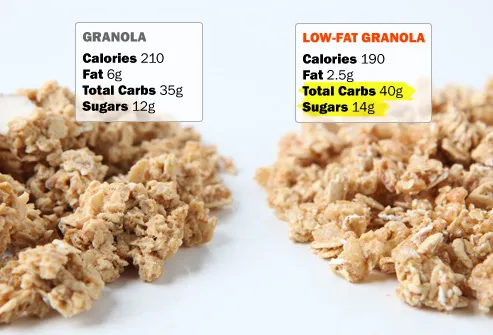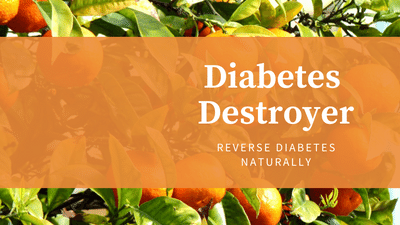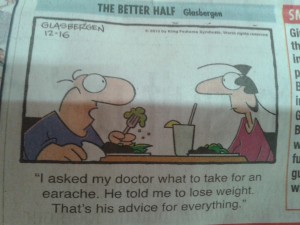We know we need to be healthy and avoid lifestyle complications, and we do sincerely try, too.
And yet we are getting more and more ill by the day. Every day we read reports of a 28-yr old undergoing 7 vessel bypass, or another 21-yr old collapsing in office. It is very common for a 35-yr old patient to say, in a very matter of fact manner, that they have been suffering from high blood pressure since 15 years!
So the sad fact is that while we’re trying to get healthier, the reverse is happening. Very often this is because we don’t quite know what to do. We hear so many claims and opinions out there, and we follow well meaning advice, only to make matters worse.
So here are a few myths regarding food.
FRUIT JUICE
I started to drink, and also to give my children, fruit juice out of a pack. Believing it to be better than soft drinks. But is it really?
Answer : NO! Packed fruit juices often contain up to 10 tsp of sugar, as much as or even more than a can of cola. Not to mention the added color, flavoring, preservatives, and whatnot. So don’t go near them. Not even if they claim to be natural, no sugar added or any other such.
But I only drink fresh fruit juice, you say? When bought at juice stalls, they often have sugar added. Lots of it. Because the fruit they use is not necessarily at peak ripeness, and could be less than ‘optimally fresh’ :) !
OK. But I only drink juice which I make at home, with no sugar added. And I feel quite virtuous doing so :). So is that OK? Unfortunately, the answer is still no.
Because the fiber is removed, we don’t feel full and may consume maybe 5 oranges while we may have eaten just 1 or 2. So the calorie count has gone up drastically. And the sugar is absorbed quickly, giving a sugar high, raising insulin levels inordinately. One glass of juice can be the sugar equivalent of 3 bars of chocolate! Over a period of time, obviously this can lead to ill health.
That “healthy” berry blend at a smoothie shop can have a whopping 80 grams of sugar, 350 calories or more, little protein, and often no fresh fruit. Fruit “concentrates” are often used instead of fresh fruit. And sorbet, ice cream, and sweeteners can make these no better than a milkshake.
Food Fix: Get the “small” cup. Ask for fresh fruit, low-fat yogurt, milk, or protein powder to blend in protein and good nutrition.
So don’t drink your calories!
Make your own smoothie at home. Blend, don’t juice.
And add a tablespoon of coconut oil for extra creamy, flavorful, healthful result.
What do you give your child for school lunch? Fruit, cut up. Not whole, it is likely to come back.
SALAD
What? What can be healthier than a salad?
Bear with me. :)
Salads can pack in calories when doused in mayo, in fat laden dressings, and when fried elements are added, such as fried chicken or fried fish. So it doesn’t matter if its advertised as ‘fresh garden salad’ or whatever. Look for the additions. Best, avoid store-bought, ready dressings. Make your own simple vinaigrette.
CHARGRILLED FOOD
Now isn’t that taking it too far? All diets advise eating grilled meats rather than fried. And that char grilled flavor, those grill marks – that’s man food!
Be aware that charring can create carcinogenic compounds. Meat that is cooked on an open flame or at very high temperatures creates chemicals known as heterocyclic amines (HCA) and polycyclic aromatic hydrocarbons (PAH) that have been connected to cancer. Other research suggests that the high fat in meat increases hormone production, which in turn can increase the risk of hormone-related cancers like breast or prostate.
Research at the Mount Sinai School of Medicine in New York shows that frying or grilling certain foods at high temperatures produces compounds that can increase inflammation in the body, leading to diabetes, heart disease, Rheumatoid Arthritis and Osteoarthritis.
The compounds, called advanced glycation end products, appropriately called AGEs in short, are known to be scoundrels. They shorten life. Period.
Prefer food steamed, stewed, poached or lightly pan fried in good quality oil.
Of course, the method of cooking does not take away from the fact that meats, especially red meats, contain saturated fats which contribute to heart disease. And the animals are fed food laced with growth and fat enhancing hormones, which we ingest when we eat the meat. This disrupts our own hormones, and thus, our health. So look for organic meats.
To clarify : almost every English word that connotes organic – natural, naturally raised, free range, hormone-free and additive-free – can be used to describe meat, but it is far from being “certified organic”. Organic meat comes from an animal that has not been fed anything grown with toxic or synthetic fertilizers, pesticides, herbicides, fungicides or fumigants; has not been given any kind of growth hormone, antibiotic or genetically engineered product; has been conceived by organically raised animals; and has been butchered and processed following organic regulations.
SUGAR SUBSTITUTES
Substitutes like honey, agave, jaggery, date sugar, maple syrup, molasses – may seem natural and healthy. The truth is, they are no different from sugar. They have the same calories and the same effect on our bodies and our health, as does sugar. Use with the same caution as you would sugar.
Artificial sweeteners – Acesulfame potassium (Sunett, Sweet One), Aspartame (Equal, NutraSweet), Saccharin (SugarTwin, Sweet’N Low), Sucralose (Splenda), may be derived from naturally occurring substances, including herbs or sugar itself, and so may sound attractive. However, they are chemicals, and the long-term effects on the body are known to be harmful or not yet clear. They should be avoided.

They leave a sweet after taste, creating further craving for sugary foods or drinks through the day. Stevia does not add calories but acts like artificial sweeteners in the sweet craving it can cause. Agave is very high in fructose.
Choose to eat fruit for your sugar fix. I have always had a sweet tooth, But now that I know, I keep off sweets, and really, I have started to develop a slight dislike of most sweets. Some I still can’t resist! But I stick to fruit for the most part.
DIET DRINKS
Diet drinks are so called because the sugar content – massive! – is replaced with the artificial sweeteners above. They may not have the calories but they do have all the artificial flavorings, preservatives, all the chemicals as the original, and also the sweet craving effect stays.
Energy drinks also have caffeine with its side effects.
Avoid!
ORGANIC FOODS
Just because it’s organic, it’s not necessarily good for you.
Organic foods are obviously to be preferred over the hormone and pesticide-laden varieties. But use your judgment. If you use organic brown sugar, for example, be aware that is brown sugar and has the same metabolic consequences as sugar. So first see that is a food you want to add to your diet and only then choose the organic option.
LOW FAT FOODS
Check out very thoroughly. Low fat foods usually have sugar added to make them more palatable. and remember, sugar is poison!

The low-fat version of this crunchy cereal has only 10% fewer calories and is still full of sugar. Plus, the low-fat label can easily lead you to overeat. A study at Cornell University found that people ate 49% more granola when they thought it was low fat — easily blowing past the measly 10% calorie savings.
Low fat milk, Skim Milk is NOT the ideal choice. Enjoy full fat milk. Again, Sugar makes you fat. Fat makes you thin!
EGGS
This one has always been a bit confusing. Eggs are good for us. Eggs have cholesterol, avoid. No, eggs are safe. Eggs can harbor salmonella organisms, avoid.
Where is the truth?
Don’t be afraid of eggs. They are a super health food. The yolks in fact are actually a very healthy food, if consumed in moderation. They are a beneficial source of healthy fat. Many nutrients, such as vitamin A, are better absorbed with fat, making eggs a very good source of vitamin A. Research has documented that eggs do not appear to promote heart disease risk.
Current thinking is that one can eat three whole eggs every day to keep the doctor away. Whole. With yolks.
But every egg is not created equal. It’s best to buy any source of protein from an environment that is as natural as possible. For egg-producing chickens, this environment is often called “cage-free” or “free-range.”
Lightly cooked or raw eggs can carry salmonella bacteria, and should be used with caution or avoided, especially by pregnant women.
FROZEN FOOD
Always eat fresh food, right? Avoid anything packaged and stored.
Not necessarily.
Fruits and vegetables – these two food groups are just as good purchased frozen as they are fresh. In some cases, they may actually be better, because if you keep vegetables and fruits in your fridge for a long time, they lose some of their nutritional value. Whereas, buying them frozen and then defrosting when you want the fruit/vegetable can actually retain more nutrients.
Plus, they do not need preservatives added. They are convenient to have on hand and to use. Probably something you have never associated with frozen food is that you can help the planet. Buying frozen food means you can take fewer trips to get groceries, thereby reducing your individual carbon footprint.
Freezing home cooked food for later use is a great option to save on time and effort.
But obviously, food which you would avoid fresh, is not healthy frozen!!
COCONUT

The coconut has long been reviled for its saturated fat content, as a contributor to heart disease. I have spent 30 years telling my patients to avoid eating coconut and using coconut oil.
But the truth is that it is a superfood.
Considered one of the most treasured foods of all time, coconut products — including coconut flesh, coconut water, coconut oil, and coconut cream — each deliver superb health benefits.
New data is showing that saturated fats are harmless. Many massive studies that include hundreds of thousands of people prove that the whole “artery-clogging” idea was a myth (2).
Additionally, coconut oil doesn’t contain your average run-of-the-mill saturated fats like you would find in cheese or steak.
No, they contain Medium Chain Triglycerides (MCTs) – which are fatty acids of a medium length which are metabolized differently. These can even increase 24 hour energy expenditure by as much as 5%, and reduce appetite, potentially leading to significant weight loss over the long term.
Studies show that coconut oil improves important risk factors like Total, LDL and HDL cholesterol, which can actually reduce risk of heart disease. A study in 40 women with abdominal obesity, showed that supplementing with 30 mL of coconut oil per day led to a significant reduction in both BMI and waist circumference in a period of 12 weeks!
And coconut oil is one of the safest oils to use in cooking, especially cooking at high temperatures such as frying, due to its high smoking point. Plus, this ultra-safe oil can give your body important antioxidants that can help build stronger cells and improve your overall health and well being.
Coconut water is completely pure and sterile, which is one reason why it can be used for blood transfusions. It has the highest electrolyte concentration of anything found in nature.This makes it an excellent treatment for dehydration.
It improves immunity, hair, teeth, bones, lipid profile, etc, etc.
Coconut milk – fresh, not packaged, is a great alternative to dairy. Not to mention its creamy, luscious richness added to curries. Yum! So now I tell my patients to cook in coconut oil!! :)

Eat Healthy, Stay Healthy!

